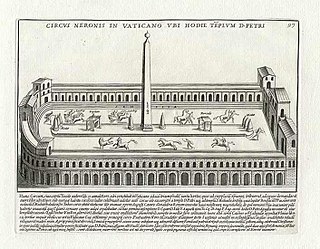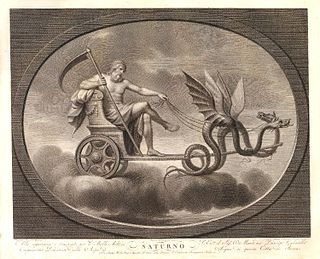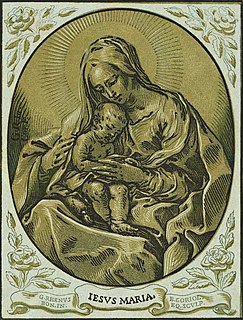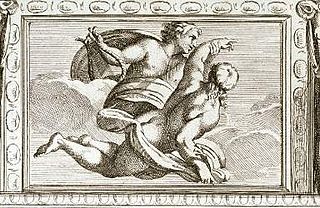
Luca Ciamberlano (born circa 1580) was an Italian painter and engraver of the Baroque period.

Luca Ciamberlano (born circa 1580) was an Italian painter and engraver of the Baroque period.
He was born at Urbino. In the early part of his life he applied himself to the study of civil law, in which he had taken a doctor's degree, when he abandoned the study of jurisprudence to devote himself to painting and engraving, particularly the latter. [1] He became the leading graphic artist of his day.
From 1599 to 1641 he resided at Rome, [1] where he executed a great number of plates from his own designs, as well as after the works of the most celebrated Italian painters, in the style of Agostino Carracci. [2] He codified and engraved Carracci's teaching system in a work published in Rome in 1626 by Pietro Stefanoni, called Scuola perfetta per imparare a disegnare tutto il corpo umano. [3]
Ciamberlano collaborated with Guido Reni between 1610 and 1612, when he made engravings based on Reni's drawings of the Life of St Philip. [4] He engraved the anatomical drawings of Pietro da Cortona between 1618 and 1620. [5] He created a nine-part series of engravings depicting the Passion of Christ, dated 1621 and probably published by Johannes Eillarts. [6]
Of his plates, 114 are known, but as many as 331 have been conjectured. [1] They were entirely executed with the graver, which he handled with neatness and intelligence; his drawing of the figure is tolerably correct. He sometimes signed his plates with his name, and sometimes marked them with the cipher LC. Among them are the following:

Francesco Bartolozzi was an Italian engraver, whose most productive period was spent in London. He is noted for popularizing the "crayon" method of engraving.

Guido Reni was an Italian painter of the Baroque period, although his works showed a classical manner, similar to Simon Vouet, Nicholas Poussin and Philippe de Champaigne. He painted primarily religious works, but also mythological and allegorical subjects. Active in Rome, Naples, and his native Bologna, he became the dominant figure in the Bolognese School that emerged under the influence of the Carracci.

Pietro Santi Bartoli was an Italian engraver, draughtsman and painter.

The Denial of Saint Peter(La Negazione di Pietro) is a painting finished around 1610 by the Italian painter Caravaggio. It depicts Peter denying Jesus after Jesus was arrested. The painting is housed in the Metropolitan Museum of Art in New York City.

Giovanni Pietro Bellori, also known as Giovan Pietro Bellori or Gian Pietro Bellori, was an Italian painter and antiquarian, but, more famously, a prominent biographer of artists of the 17th century, equivalent to Giorgio Vasari in the 16th century. His Lives of the Artists, published in 1672, was influential in consolidating and promoting the theoretical case for classical idealism in art. «Bellori is the "predecessor of Winckelmann" not only as an antiquarian but also as an art theorist. Winckelmann's theory of the "ideally beautiful" as he expounds it in Geschichte der Kunst des Altertums, IV.2.33 ff., thoroughly agrees—except for the somewhat stronger Neoplatonic impact, which is to be explained perhaps more as an influence of Raphael Mengs than as an influence of Shaftesbury—with the content of Bellori's Idea ; he frankly recognizes this indebtedness in Anmerkungen zur Geschichte der Kunst des Altertums (1767), p. 36.» As an art historical biographer, he favoured classicising artists rather than Baroque artists to the extent of omitting some of the key artistic figures of 17th-century art altogether.

Francesco Brizio (1574–1623) was an Italian painter and engraver of the Bolognese School, active in the early-Baroque.

Lazzaro Baldi was an Italian painter and engraver of the Baroque period, active mainly in Rome.
Giulio Cesare Venenti (1609–1697) was an Italian engraver of the Baroque period. He was born in Bologna, where he first apprenticed under Francesco Brizio and Reni. He is best known for engravings of painters of Northern Italy including Parmigianino, Domenico Maria Canuti, and Annibale Carracci, including his landscapes.

Pietro Bonato (1765–1820) was an Italian painter and engraver of the Baroque. He was born at Bassano and was a pupil of Giovanni Volpato. He engraved plates after Guido Reni and Correggio.
Antonio Zabelli (1742-1796) was an Italian engraver born in Florence. He engraved several portraits for the collection published by Francesco Allegrini at Florence, in 1762; and some plates after the principal pictures at Naples: among them Mary Magdalene after Guercino; Flight to Egypt and Meeting of Christ and St. John after Guido Reni; and Three Marys at the Tomb of Christ after Annibale Carracci.
Niccolò Billy was an Italian engraver of the 18th century, active in Rome. Originally from France, he was active around 1734 along with his brother Antonio Billy. They engraved several portraits and historical subjects. Niccoló engraved some plates for the Museum Florentinum, including self-portraits of Federico Zuccari; Hans Holbein; Pier Leone Ghezzi; and Giovanni Morandi. He also engraved Cardinal Pompeo Aldrovandi after G. Berti; Infant Jesus sleeping; Cardinal Spinelli; St. Philip Neri kneeling before the Virgin after Sebastiano Conca; The Holy Family: after Annibale Carracci; St Michael Archangel after Pietro da Cortona (1689); and The Flight into Egypt; after Guido Reni.

Bartolommeo Coriolano was an Italian engraver during the Baroque period. His father, Cristoforo Coriolano, and brother, Giovanni Battista Coriolano were also woodblock printers, although there is some doubt over the actual relationship between Cristoforo and Bartolommeo Coriolano. Coriolano had a daughter, Teresa Maria Coriolano, who later became a painter and engraver.

Italian Baroque art is a term that is used here to refer to Italian painting and sculpture in the Baroque manner executed over a period that extended from the late sixteenth to the mid eighteenth centuries.
Robert van Audenaerde or Ouden-Aerd (1663–1748) was a Flemish painter and engraver.

Charles Audran (1594–1674) was a French engraver.
Jean Audran (1667-1756) was a French engraver and printmaker. The brother of Benoit, and the third son of Germain Audran, he was born at Lyons in 1667. After learning the rudiments of the art under his father, he was placed under the care of his uncle, the famous Gérard Audran, in Paris. Before he was twenty years of age he displayed uncommon ability, and became a very celebrated engraver. In 1706 he was made engraver to the king, with a pension and apartments at the Gobelins. The hand of a great master is discernible in all his plates; and without having attained the extraordinary perfection of Gérard Audran, his claim to excellence is very considerable. He died in 1756. His principal prints are:

Carlo Cesio or Carlo Cesi was a Baroque-style painter and engraver of the Roman school.
Guillaume Chasteau (1635–1683) was a French engraver.

Pieter de Bailliu was a Flemish engraver.

Sir Nicolas Dorigny was a French engraver, the youngest son of Michel Dorigny, and was born in Paris in 1652 or 1658. His education prepared him for the legal field, and he followed that profession until he was thirty years of age, when, as a result of deafness, he turned to the arts.
Attribution:
| Wikimedia Commons has media related to Luca Ciamberlano . |
| This article about an Italian painter born in the 17th century is a stub. You can help Wikipedia by expanding it. |